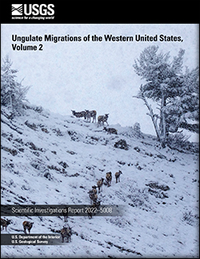Ungulate Migrations of the Western United States, Volume 2
Links
- Document: Report (58.4 MB pdf)
- Related Works:
- Data Release: USGS data release - Ungulate Migrations of the Western United States, Volume 2
- Download citation as: RIS | Dublin Core
Abstract
Migration is widespread across taxonomic groups and increasingly recognized as fundamental to maintaining abundant wildlife populations and communities. Many ungulate herds migrate across the western United States to access food and avoid harsh environmental conditions. With the advent of global positioning system (GPS) collars, researchers can describe and map the year-round movements of ungulates at both large and small spatial scales. The migrations can traverse landscapes that are a mix of different jurisdictional ownership and management. Today, the landscapes migrating herds traverse are increasingly threatened by fencing, high-traffic roads, oil and gas development, and other types of permanent development. Through the use of GPS collars, a model of science-based conservation emerged in which migration corridors, stopovers, and winter ranges can be mapped in detail, thereby allowing threats and conservation opportunities to be identified and remedied. In 2018, the U.S. Geological Survey (USGS) assembled a Corridor Mapping Team (CMT) to work collaboratively with western states to map migrations of Odocoileus hemionus (mule deer), Cervus canadensis (elk), and Antilocapra americana (pronghorn). Led by the USGS Wyoming Cooperative Fish and Wildlife Research Unit, the team consists of Federal scientists, university researchers, and biologists and analysts from participating State and Tribal agencies. The first set of maps described a total of 42 migrations across 5 western states and was published in 2020 as the first volume of this report series. This second volume describes an additional 65 migrations mapped within 9 western states and select Tribal lands. As the western United States continues to grow, this report series and the associated map files released by the USGS will allow for migration maps to be used for conservation planning by a wide array of State and Federal stakeholders to reduce barriers to migration caused by fences, roads, and other development.
Suggested Citation
Kauffman, Matthew, Lowrey, Blake, Beck, Jeffrey, Berg, Jodi, Bergen, Scott, Berger, Joel, Cain, James, Dewey, Sarah, Diamond, Jennifer, Duvuvuei, Orrin, Fattebert, Julien, Gagnon, Jeff, Garcia, Julie, Greenspan, Evan, Hall, Embere, Harper, Glenn, Harter, Stan, Hersey, Kent, Hnilicka, Pat, Hurley, Mark, Knox, Lee, Lawson, Art, Maichak, Eric, Meacham, James, Merkle, Jerod, Middleton, Arthur, Olson, Daniel, Olson, Lucas, Reddell, Craig, Robb, Benjamin, Rozman, Gabe, Sawyer, Hall, Schroeder, Cody, Scurlock, Brandon, Short, Jeff, Sprague, Scott, Steingisser, Alethea, and Tatman, Nicole, 2022, Ungulate migrations of the western United States, volume 2: U.S. Geological Survey Scientific Investigations Report 2022–5008, 160 p., https://doi.org/10.3133/sir20225008.
ISSN: 2328-0328 (online)
ISSN: 2328-031X (print)
Study Area
Table of Contents
- Acknowledgments
- Abstract
- Introduction
- State-Led Conservation Efforts in the Western United States
- Herd Summaries
- References Cited
- Appendix 1. Methods
| Publication type | Report |
|---|---|
| Publication Subtype | USGS Numbered Series |
| Title | Ungulate migrations of the western United States, volume 2 |
| Series title | Scientific Investigations Report |
| Series number | 2022-5008 |
| DOI | 10.3133/sir20225008 |
| Publication Date | April 07, 2022 |
| Year Published | 2022 |
| Language | English |
| Publisher | U.S. Geological Survey |
| Publisher location | Reston VA |
| Contributing office(s) | Coop Res Unit Seattle |
| Description | Report: xix, 160 p.; Data Release |
| Country | United States |
| Other Geospatial | western United States |
| Online Only (Y/N) | N |


